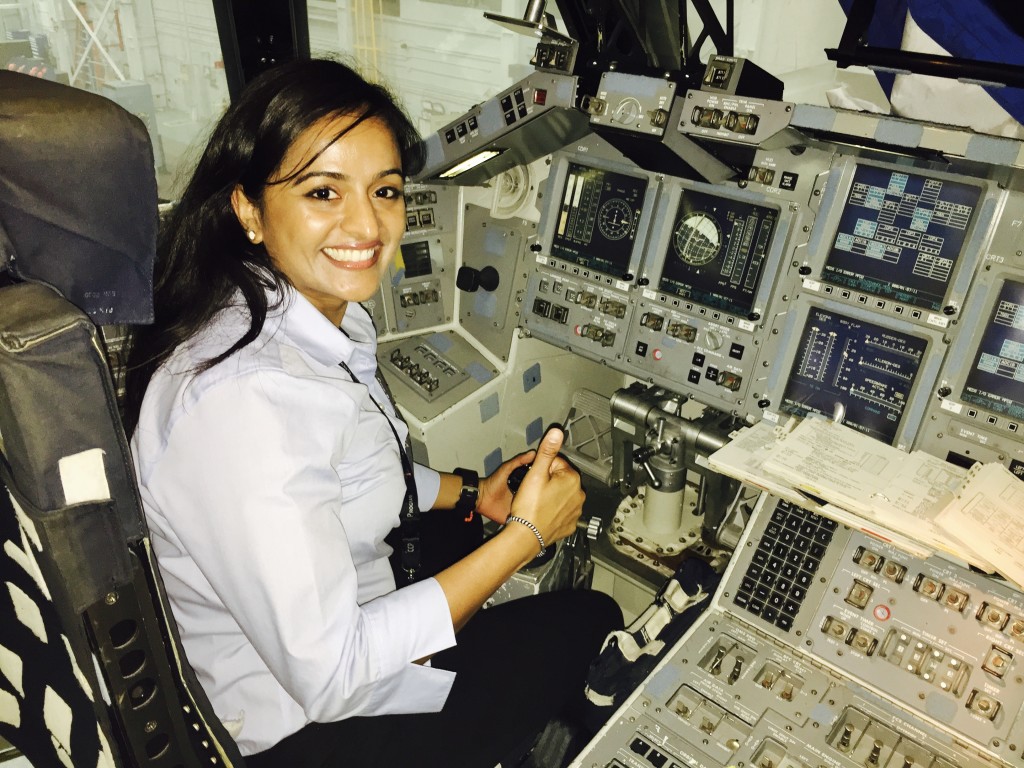
Kavya’s keen interest and passion in spacesuit design has additionally led her to develop a key technology to repel lunar dust from spacesuits – the sharp abrasive lunar dust posed a significant hindrance during the Apollo program, damaging spacesuits and creating pressure leaks. Her self-cleaning material sample prototypes are currently being tested on a platform outside the International Space Station! This technology will be crucial as we work towards achieving NASA’s Artemis missions in the 2020s to return humans to the surface of the Moon.
Kavya also teaches the next generation of spacesuit designers and engineers as Adjunct Faculty at the University of North Dakota (UND), and has recently become a Mum. She recently told her alma mater MIT that her ultimate goal is to, “design the next-generation space suit to enhance human capabilities when we go back to the moon—and possibly wear it one day on a mission.”
Rocket Women were thrilled to have the opportunity to talk to Kavya about her passion for human spaceflight and spacesuit design, what success means to her and how her family has helped to shape her career path.
What was the path to get to where you are now in the space industry and what drives your passion for space?
My curiosity in space started when I was 3 years young. I was inspired by the stories my father narrated about Apollo astronauts, cosmonauts and the first Indian cosmonaut in space, while also patiently taking the time to answer every question I had about space and the cosmos. It was my parents’ encouragement to pursue something I am passionate about and to give my best to whatever path I chose that gave me the courage to step into this field. That’s where it started, as a child I was curious and wondered if there were sharks on the moon and whether I can one day explore this myself, and several years later I am living my dream today, working on one of humankind’s greatest endeavors. Working in the space industry makes me realize the immense possibilities of being a human.
It was my parents’ encouragement to pursue something I am passionate about and to give my best to whatever path I chose that gave me the courage to step into this field.
![Kavya Manyapu working on the Boeing Starliner Spacesuit, to be worn by astronauts during launch and re-entry onboard the Starliner spacecraft [Image credit: Boeing Company / Kavya Manyapu]](https://rocket-women.com/wp-content/uploads/2019/11/IMG_7535-1024x768.jpg)
I’ve always had a keen interest on spacesuits and a fascination for them. While I’ve been working on the next generation spacecraft at Boeing building the CST-100 Starliner spacecraft, my interest in getting an advanced degree at the University of North Dakota opened an opportunity to deep dive in the area of spacesuits for long duration missions.
During the early days of my Ph.D. research, I had an opportunity to talk to Apollo Astronaut Alan Bean. It was during the same time I was reading papers on post flight investigations of Apollo spacesuits and hardware, particularly his suit being contaminated by lunar dust and the deleterious impacts of lunar dust faced by astronauts during the Apollo missions. Inspired by the conversation with him and my personal aspiration to make a small contribution towards space exploration led to the conception of the SPIcDER (pronounced “Spider”) Technology.
Inspired by the conversation with him [Apollo Astronaut Alan Bean] and my personal aspiration to make a small contribution towards space exploration led to the conception of the SPIcDER (pronounced “Spider”) Technology. SPIcDER (Spacesuit Integrated carbon nanotube Dust Ejection/ Removal system) was developed to overcome the challenges of dust contamination of spacesuits and other hardware deployed on the lunar surface, a capability particularly required if we want to go back to the moon for long duration missions. Inspired by super hero movies (watched a lot as a kid) specifically Spiderman and Batman (hence the name SPIcDER), the research led to developing the technology that repels and removes dust from spacesuits..
SPIcDER (Spacesuit Integrated carbon nanotube Dust Ejection/ Removal system) was developed to overcome the challenges of dust contamination of spacesuits and other hardware deployed on the lunar surface, a capability particularly required if we want to go back to the moon for long duration missions. Inspired by super hero movies (watched a lot as a kid) specifically Spiderman and Batman (hence the name SPIcDER), the research led to developing the technology that repels and removes dust from spacesuits (and other flexible materials) using Carbon Nanotube fibers that are embedded into suits and energized using a cleaning signal.
SPIcDER has been successfully tested in various environments here on earth including on a fully functioning spacesuit knee-joint. Early generation prototypes of this self-cleaning material are now being exposed to the space environment on the MISSE platform on the International Space Station. I am now working on pursing opportunities for follow-on experiments on ISS to further advance this technology.
![Kavya Manyapu working on the Boeing commercial crew Starliner vehicle [Credit: Kavya Manyapu / Boeing]](https://rocket-women.com/wp-content/uploads/2019/11/1_Kavya_Starliner-Spacecraft-1024x819.jpg)
Growing up, I always thought a career path would be a straight road. You work hard, get good grades, get into a good university and land your dream job. Conversely, this journey so far has been nothing but exciting with its twists and turns, ups and downs and, failures and successes.
Was there anything unexpected about your career journey that you thought would be different to your initial expectations?
Growing up, I always thought a career path would be a straight road. You work hard, get good grades, get into a good university and land your dream job. Conversely, this journey so far has been nothing but exciting with its twists and turns, ups and downs and, failures and successes. It’s been a learning expedition, giving a deeper experience of life, both inner and outer. I like it this way since I’ll have many stories to share with my kids, grandkids and the next generation!
What does success mean to you?
When I’m able to use myself to my full potential, regardless of the outcome, that’s what I call success. I don’t think I’ve reached that mark yet and still exploring this potential.
![Kavya Manyapu, Starliner Spacesuit Lead, wearing the Boeing Starliner spacesuit [Image credit: Boeing/Kavya Manyapu]](https://rocket-women.com/wp-content/uploads/2019/11/IMG_5064-1-768x1024.jpg)
I was super thrilled and inspired when I first met my favorite astronaut Sunita Williams during my undergrad, that reinforced the notion that we can aspire and achieve to be anything we dream of! Now I get to work with her on my job!
Who were your role models when you were growing up? How important are role models to young girls?
Having positive role models will help us uncover our true potentials and when we see someone in a path that we aspire, it reinforces our aspiration and motivates us to strive to uncover our own talents. Role models for me started at home- my parents and grandma were my first role models. symbolizing hardwork, dedication and compassion.
With exposure to various cultures and people via workshops, extra-curricular activities and change of countries (grew up in India an moved to the US after high school), I realized that every person I met had some unique ability that has inspired me. In that sense, everyone that I came across have taught me something about personal and professional growth. I’ve also had the opportunity to meet several astronauts who have inspired me. Particularly, I was super thrilled and inspired when I first met my favorite astronaut Sunita Williams during my undergrad, that reinforced the notion that we can aspire and achieve to be anything we dream of! Now I get to work with her on my job!
My family has been the backbone of everything I am today.
How did your family help to shape your career path in STEM?
My family has been the backbone of everything I am today. Starting with patiently feeding a 3 year old’s curiosity, to encouraging me to pursue what I am passionate about, taking a big step in leaving their home country and moving to the US so I could pursue my dream of working in the space industry, and more importantly advising me that no matter what career path I choose, I should give my 100%. In my humble opinion empowerment starts at home, and they continue to support me today in both my personal and professional paths.
If you had one piece of advice for your 10-year-old self, what would it be?
Would there be any decisions that you’d have made differently?
The best advice I received as a 10 year old which I continue to follow – , no matter what it is you are doing, try to do your best and give it your 100%. I’m grateful for receiving this advice (and many other) from my parents. Don’t think I would do anything differently, otherwise I may probably not be doing the things I dreamt of as a 10-year-old that I get to do today.
